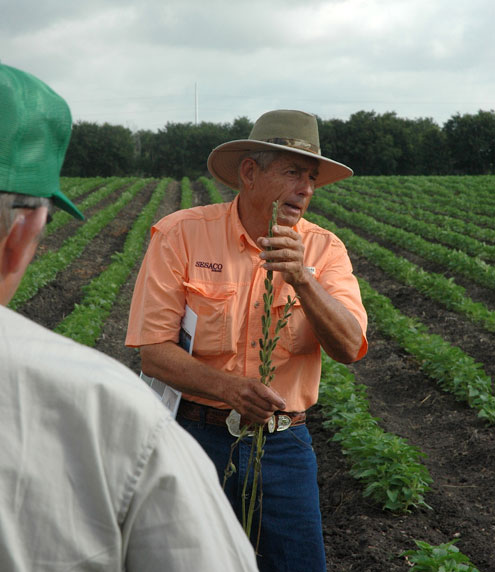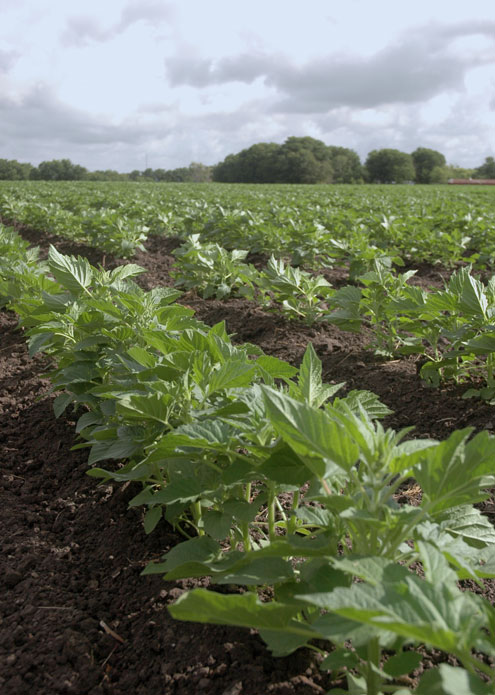THRALL – This year’s showstopper at the 49th Stiles Farm Field Day was a large sesame trial that has “bellwether” traits during times of drought, according to experts.
“This is the first time since I’ve been farm manager at the Stiles Farm we’ve had sesame and it’s got a lot of potential for Blacklands farmers,” said Archie Abrameit, Texas AgriLife Extension Service farm manager.
Dr. Charles Stichler, a retired AgriLife Extension agronomist and now an independent consultant in Knippa, has spent much of his career specializing in sesame production for Texas. He discussed the Sesaco Corp. line of sesame at the Stiles Farm, which was thriving even as some of the corn and other crops were showing moisture stress due to lack of rain.
“At the Luling Foundation (east of San Antonio), everything else was dead last year during the drought, but the sesame was alive and well,” Stichler said.
The Luling Foundation serves farmers in Caldwell, Gonzales and Guadalupe counties and is located west of Luling.

Dr. Charles Stichler, a retired Texas AgriLife Extension Service agronomist and independent consultant in Knippa, discusses sesame trials on display at the Stiles Farm Foundation. (Texas AgriLife Extension Service photo by Blair Fannin
Approximately two-and-a-half pounds of sesame seeds were planted per acre at the Stiles Farm on May 10. The crop typically matures in 90 days.
“It’s heat, deer and insect tolerant,” Stichler said. “It’s a good rotational crop.”
He said at harvest time, the stalks get brittle and farmers don’t have to labor getting their fields clean with repetitive plowing. One pass will get the field clean, he said.
“It basically turns to powder,” Stichler said.
Most U.S. sesame is exported to China and used in a variety of foods. The oil is also valuable, he said.
Per acre cost to farmers is about $10, Stichler said, and with minimal maintenance the crop can be another revenue stream for producers. Market prices are approximately $4 a pound for harvested sesame, he said.

Approximately two-and-a-half pounds of sesame seeds were planted per acre at the Stiles Farm on May 10.
At the weed-control tour, Dr. Paul Baumann, AgriLife Extension weed specialist in College Station, discussed common waterhemp and Palmer amaranth. Common waterhemp has shown several instances of glyphosate (Roundup) resistance in Southeast and Central Texas. Palmer Amaranth resistance has been documented in several fields in West Texas.
He stressed to producers to take immediate preventive action, such as keeping fields clean and rotating herbicide chemistries, especially with regard to using soil-applied herbicides before or at planting.
“If you leave one weed in the cotton patch and don’t get out of the pickup and go hoe it out, you can imagine the problem you are going to have next year because it can can shed 500,000 seeds,” he said. “What we are seeing this year are resistant weed patches that are obviously where one or a few resistant plants went to seed last fall.”
Baumann said Roundup and other glyphosate products are too effective on too many weeds to discontinue use of them, but they must be part of a larger herbicide program.
“We are going to have to spend more money to include more herbicides than just the glyphosate products,” he said. “However, I would stress the point that there is value in keeping weeds from coming up with the crop. Research shows the first 10 weeks are critical to competition with weeds. If you wait two to three weeks to treat, they are going to pick your pocket.”
Baumann suggested applying an early preventative blanket of herbicide, then managing whatever comes up later with glyphosate or other alternative post-emergence products.
“Using only glyphosate in your weed control program ensures that at some point, resistant biotypes of common waterhemp or Palmer amaranth pigweed will show up,” Baumann said. “Unfortunately, by the time you figure out it is resistant, you have made one or more applications of glyphosate and the weed is now too big to manage with any other products. Bottom line, treat early on small weeds that appear in your fields so you have the flexibility to use some other product if those weeds don’t die.”
Dr. Tom Isakeit, AgriLife Extension plant pathologist, College Station gave an update on cotton root rot control methods. He discussed the latest research activities using the fungicide, Topguard, which received Section 18 approval from the Texas Department of Agriculture. The research is supported by Texas farmers, through Cotton Inc. and the Texas State Support Committee.
“We have ongoing research in application rates and methods for consistent control,” he said.
Isakeit said the research is evaluating both pre-planting and post-planting applications. One issue Isakeit said they are researching is minimizing phytotoxicity (poisionous threat) to the cotton plant. The chemical is sprayed into the open furrow at planting, but some farmers do not have the proper equipment to do this.
The special approval for use of Topguard will expire soon, but Isakeit is hopeful the Section 18 will be renewed next year.
The research results are highly anticipated since cotton root rot not only affects yields, but also fiber quality, Isakeit said.
Also discussed were several new traits that will be available in cotton seed over the next three to four years, including insect traits and herbicide tolerance traits, said Dr. Gaylon Morgan, AgriLife Extension cotton specialist, College Station.
He said these technologies will provide producers new opportunities and also a learning curve.
“In 2013, assuming some regulatory approval by a few foreign countries, Bayer Crop Science will have released the Twinlink insect traits, and it will be coupled with stacked Glytol/Liberty Link herbicide tolerance traits,” Morgan said.
He said once Bayer Crop Science’s traits are available to the producers, “this will increase availability of seed technology traits to producers by multiple companies.”
The Glytol/Liberty Link cotton varieties will increase the options for rotating broad spectrum herbicides in cotton. However, the glyphosate and Liberty should not be tank-mixed due to antagonism on weed control, Morgan said.
During the noon program, Dr. Pete Gibbs, AgriLife Extension associate director at College Station, told attendees crop and range conditions were much improved from last year’s field day event and that producers were “blessed to receive the rain that has fallen so far this year.”
“We are glad you’ve come to this field day event as the Stiles Farm features 3,000 acres of diversified crop and livestock operations,” he said. “This farm blends the activities of Texas AgriLife Extension Service and Texas AgriLife Research, helping producers solve problems and move forward with economic feasibility.”
At the field day, Scott Ging was named Taylor Chamber of Commerce Agriculturalist of the Year. Stiles Farm Foundation scholarship winners were Allison Hodde from Travis County and Matthew Liverman from Bastrop County. Both will attend Texas A&M University.